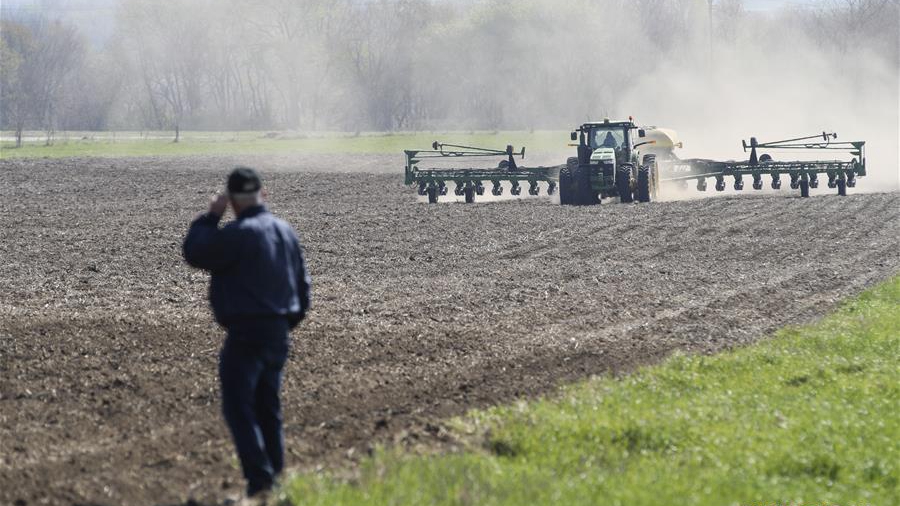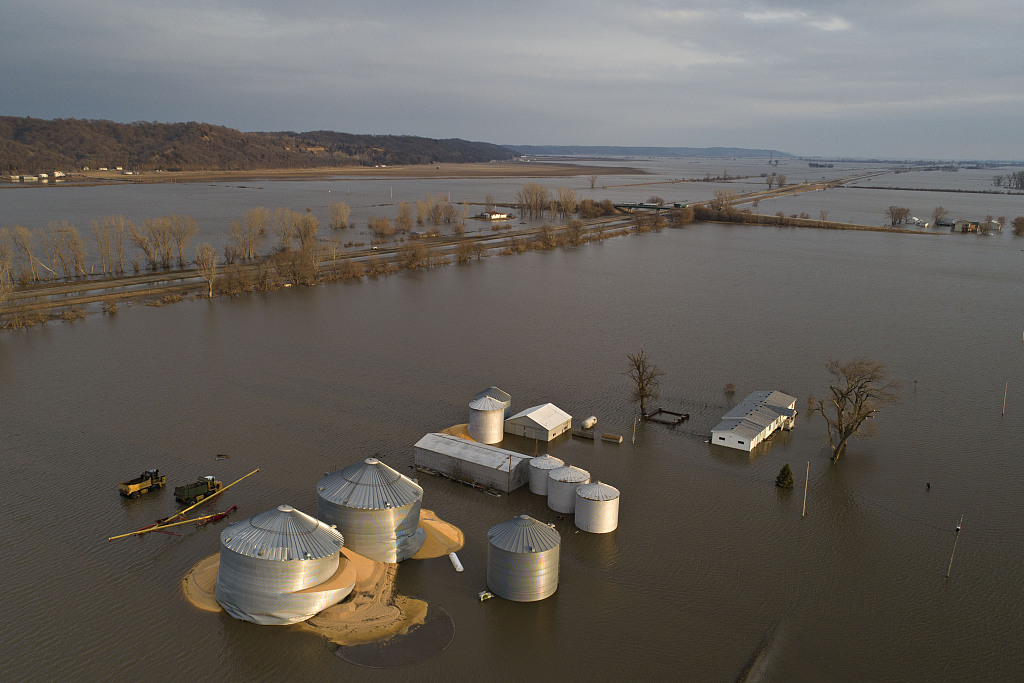
Bill Pellett watches as his son Bret plants corn with a planter machine at their family farm in Atlantic, Cass County, Iowa, the United States, April 24, 2019. /Xinhua
Bill Pellett watches as his son Bret plants corn with a planter machine at their family farm in Atlantic, Cass County, Iowa, the United States, April 24, 2019. /Xinhua
Editor's note: Mahesh Kommarredi is the founder of the tech and robotics company Best MK, which is pioneering cutting-edge solutions in the agriculture industry. The article reflects the author's opinions and not necessarily the views of CGTN.
The war in Ukraine has hit the average American pocket. It's not just energy prices that are soaring, food is becoming far more expensive too. Yet outdated farming practices and a powerful, vocal agriculture lobby are blocking the change needed for a sustainable future for domestic food production in the U.S.
In order to make the U.S. robust against international food shocks in the long term, we have to fundamentally curb the ecological damage being done by our outdated farming industry. To do that, we must fundamentally rethink how we produce and provide our food. It's time to end harmful farming practices and subsidize sustainable, lower emission food production systems instead.
World food prices have hit an all-time high following conflict between Europe's breadbaskets Ukraine and Russia. Together, both Russia and Ukraine accounted for 30 percent and 20 percent of the world's grain supply in 2021, respectively. Between export bans, labor shortages, and blocked off seaports, the decrease in exports from these countries has sent reverberations across the world's food supply chain.
The UN's Food and Agriculture Organization has claimed that the war in Ukraine has been responsible for a 17.1 percent global rise in the price of grains, including wheat, oats, barley, and corn. This has trickled down to American consumers; U.S. food prices have experienced a 20.7 percent increase since last year.
Amongst the demands for greater energy independence, many are pointing to America's need to become truly food independent too. Yet currently, a lack of sustainability is built into the core of America's food production architecture. In other words, we're extracting wealth from tomorrow to put food on our plates today.
For example, desertification is spreading across the U.S. Along with climate change, poor farming practices are in part to blame. 17 states in the Western U.S. can be categorized as arid, semi-arid, or dry sub-humid, with 40 percent of the continental United States at risk of desertification.
This has largely been a result of overgrazing and poor irrigation practices. Scientists believe that reversing desertification in these arid lands will take 100 years.

Floodwaters surround corn sitting under collapsed grain bins over Pacific Junction, Iowa, U.S., March 23, 2019. /CFP
Floodwaters surround corn sitting under collapsed grain bins over Pacific Junction, Iowa, U.S., March 23, 2019. /CFP
Yet beyond increasingly arid land, climate change is already creating severe problems for the American agricultural industry. For example, in 2019, flash floods in eastern Nebraska and western Iowa saw rain levels between 400 percent to 600 percent higher than normal, according to the National Weather Service.
These flash floods triggered a serious knock-on effect on American food prices, triggering a three-year high in the price of corn according to the Financial Times.
Flashfloods are not the only threat presented by climate change. A landmark UN study revealed that climate change threatens a million species with extinction. Included in this list are the pollinators, like bees, butterflies, and wasps. If they die, this could trigger an untold collapse of global agriculture.
American agriculture not only suffers from the effects of climate. It contributes to it too. In 2020, the American agricultural economic sector accounted for 11 percent of total American greenhouse gases, an increase of 6 percent since 1990. This has largely been driven by a 62 percent growth in combined CH4 and N20 emissions from fertilizers and livestock manure systems.
Fundamentally, our food production systems are unsustainable. To keep food on the table, we need a fundamental rethink in how we get food from farm to plate in America.
Of course, increased investments in the growing agri-tech sector would help. For example, fungi-fertilizers have shown tremendous promise in their potential to become a fertilizer of the future, according to the University of Cambridge.
Yet America's agricultural industry faces more systemic issues. As food markets globalized in the 1900s, farmers would specialize in select commodity crops and animals to increase profits through their exports. This coincided with a huge marketing push from agribusiness companies, who proposed new machines and agrochemicals in order to boost yields and ultimately, profits.
In the 1970s, under the secretary of agriculture Earl Butz's "get big or get out" program, which saw subsidies go to farms that grew crops at scale, contributed to desertification in the long-term. The same agricultural lobby that favors big, centralized farming is the one that has blocked some smart ecological solutions.
From a tax on livestock emissions, cleverly rebranded as "cow tax," to blocking the American Clean Energy and Security Act in 2009, the agricultural lobby uses many similar tactics to the oil lobby to suppress laws that hurt their interests. In fact, the six biggest agriculture groups have spent $200 million in lobbying since 2000. It's them we have to thank for the fact that American taxpayers subsidize the animal food system with $38 billion a year.
Fundamentally, we need to rethink how we subsidize and structure our food production system. Subsidies need to be taken away from the sectors that contribute to the desertification of land and emission of greenhouse gases. Instead, we must direct those subsidies towards those food producers that produce food in a sustainable way, through using regenerative farming and careful crop and cattle rotation. Similarly, we must invest in the new wave of agri-tech businesses that are working on innovative solutions to help mend our broken food production systems.
As long as inefficient, unsustainable farming practices persist in the U.S., our domestic food producers will face an increasingly bleak future. Yet it's not too late to U-Turn. By imagining policies that bake long-term sustainability initiatives into our agriculture industry, we can rebuild an agriculture industry that protects people, producers, and the planet in the long term.
(If you want to contribute and have specific expertise, please contact us at opinions@cgtn.com. Follow @thouse_opinions on Twitter to discover the latest commentaries in the CGTN Opinion Section.)

